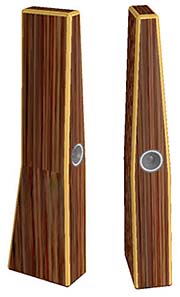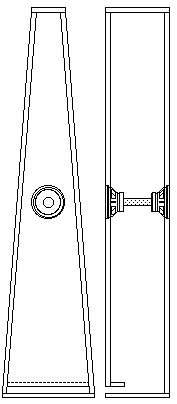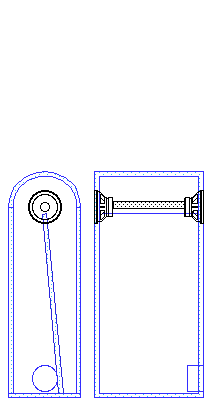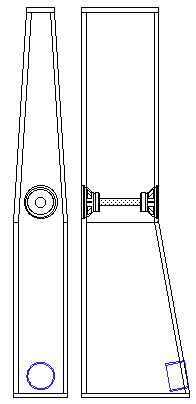| Push-Push Bi-polar
ML-TQWT Concepts with 2 radio Shack 40-1354 full-ranges |
||||||||||||||||||||
| These concepts came about
because of a discussion on the Full-Range Forum. Someone asked what could be
done with 2 drivers per side and i suggested this. The discussion even lead to someone
doing some experiments to see if the concepts work. His edited post is in the sidebar
at the bottom. The drawings show 3 variations -- one of the other Full Rangers, Steven Brown, is donating a pair of 40-1354s so that I can build a pair -- I had already done a swap for my 1st pair. We are going to do the folded ones. This kind of configuration is something i have been thinking about for some time. This push-push toobz woofer is an earlier concept. Push-push cancels out a lot of newtonian load on the box for better micro-dynamics & inherently has no baffle-step. By mechanically coupling the two drivers we are actively canceling any motion that would be imparted on the enclosure largely removing driver induced resonances in the cabinet walls. A similar trick is the wedge between the back of the driver and the back of the enclosure. This passively loads the drivers newtownian motion (ie the cone moves in -- the enclosure -- or part of it -- moves the other way) more evenly thru-out the cabinet (putting less stress on the baffle). since both drivers go from 2pi to 4 pi radiation in the same place the loss below the bafflestep from one driver folds around the cabinet and perfectly compensates for the baffle-step loss of the opposite driver. Drivers need to be working in phase. These designs are all based on Bob Brines straight ML-TQWT for the 40-1354 which was developed using Martin King's TL software. |
||||||||||||||||||||
|
<clik images for larger drawings with dimensions and other details> |
||||||||||||||||||||
|
[ <-- Back to the Finlayson Arm Loudspeaker Lab | T-Line Speakers]
|
||||||||||||||||||||



